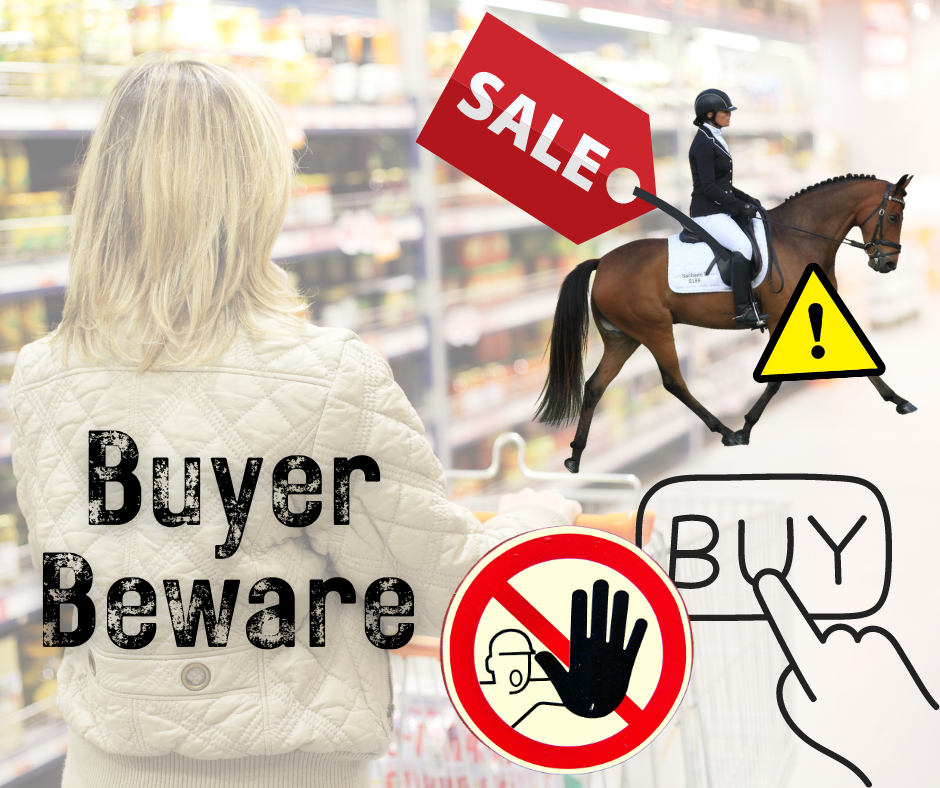Buying Horses - buyer beware!
Buying Horses - Buyer Beware
Buying a horse is a major investment and if you end up with a horse that is unsound, difficult or not appropriate for you and the financial and emotional costs can be high.
Caveat emptor is a Latin phrase meaning “let the buyer beware”. This is the idea that a buyer must not assume the “quality” of what they are purchasing is guaranteed. It means that unless you have some form of guarantee or insurance to cover anticipated future risks, you need to rely on your own investigations, inspections and inquires to make good purchase decisions. This is so important to understand when it comes to buying horses. If your new horse turns out to be not what you expected it can be very difficult to return the horse or get your money back.
Whilst there are many lovely horses on the market being sold by honest people, there are also the following:
Horses that have soundness issues that sellers are aware of or have an inkling about that want to move the horse on because it is expensive to keep them (e.g. corrective shoeing), reducing their performance ability, impacting the horses behaviour etc. They may or may not be completely honest about this and can recommend the horse for lower level activities hoping the horse will be able to cope better.
Horses with soundness issues that sellers are not aware of.
Horses that are difficult to handle in certain situation such as floating problems, separation anxiety, anxiety at events, food aggression etc. that sellers are aware of and want to move the horse on. Again, they may or may not be honest about these issues or understate the extent of the issue.
Besides these situations, it is impossible for a seller to determine the horse is going to be a good match for you, what you are doing to do with the horse and how you are going to keep and manage the horse! So many of my clients, that are new to horse ownership, where sold horses that were labelled “perfect beginner” horses. These horses have ended up not coping at all with being a beginner horse.
Finally, even if a seller is as open and honest as they can be, it doesn’t mean that it will register to you as significant. For example, a client had a horse that she bought that she was told could be difficult for the vet to needle. She discovered the full significance of this issue when the horse reared up, pulled back and jumped a 5 ft tie up rail the first time a vet tried to give him a needle!
Therefore, it is very important to boost your knowledge and skills in assessing the appropriateness of horses and potential red flags when you are are browsing advertisements, watching sales videos and inspecting horses you are considering purchasing.
Last year I wrote a book to record my insights and assessment guidelines for buying horses. My aim was to boost people’s buyer awareness to stop them falling into the trap or overlooking red flags that many of my clients had done by purchasing unsound, difficult or inappropriate horses. The book describes my process and has checklists for each stage of looking at advertisements, videos, inspecting the horse etc.
This week I received the following message from someone who is out horse shopping and is using the book to help them in their search:
“Hey Shelley, took your checklist with me to view two horses over the past two days. Neither of them were able to transition from trot to canter. One was a young thoroughbred and the other a warmblood X. When I arrived both were exhausted. They were also hollow backed and sore in the C2-C3 area. Really sad, price range was from $5K to $8K! I didn't even bother to get them tacked up. Thank you for giving such a concise checklist. I now feel so much more confident at viewing a horse for sale.”
My book is called “Buying and Supporting a New Horse - The Essential Guide”. It is available as an eBook worldwide and is only $9.99 AUD.
If you are in Australia you can download from Apple Books or Kobo.
If you have any stories or wisdom from your “buyer beware” experiences I would love to hear them!
